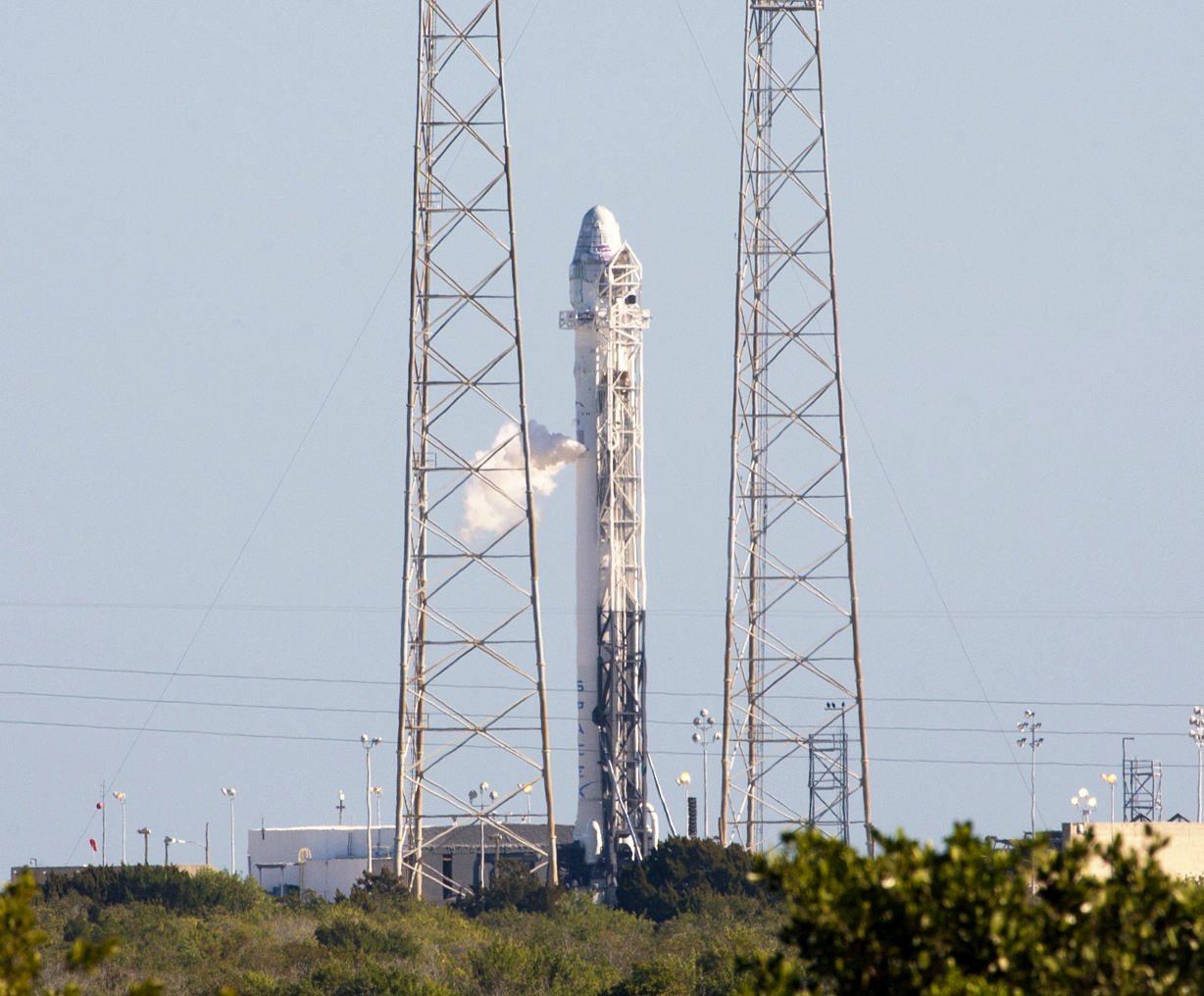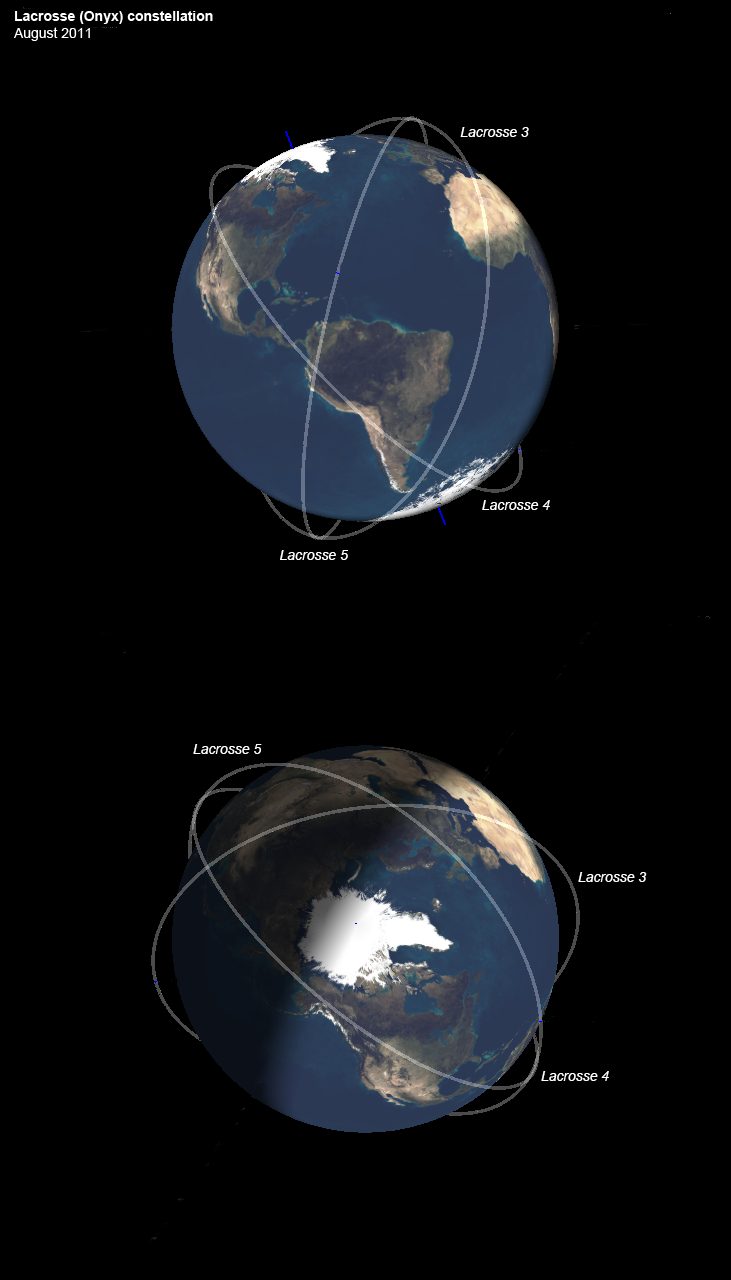|
Launch Complex 40
Space Launch Complex 40 (SLC-40), previously Launch Complex 40 (LC-40) is a launch pad for rockets located at the north end of Cape Canaveral Space Force Station, Florida. The launch pad was used by the United States Air Force for 55 Titan III and Titan IV launches between 1965 and 2005. The facility underwent multiple upgrades including the design and construction of towers with retractable and foldable platforms for vehicle assembly, instrumentation and monitoring. After 2007, the US Air Force leased the complex to SpaceX to launch the Falcon 9 rocket. As of August 2022, there have been 93 launches of the Falcon 9 from the complex. The site was heavily damaged following the September 2016 Falcon 9 flight 29 incident, due to a catastrophic failure during a static fire test. The complex was repaired and returned to operational status in December 2017 for the CRS-13 mission. Launch history Rocket launches Titan The first launch from SLC-40 (initially named LC-40) ... [...More Info...] [...Related Items...] OR: [Wikipedia] [Google] [Baidu] |
SpaceX CRS-13
SpaceX CRS-13, also known as SpX-13, was a Commercial Resupply Services, Commercial Resupply Service mission to the International Space Station launched on 15 December 2017. The mission was contracted by NASA and is flown by SpaceX. It was the second mission to successfully reuse a SpaceX Dragon, Dragon capsule, previously flown on SpaceX CRS-6, CRS-6. The first stage of the Falcon 9 Full Thrust rocket was the previously flown, "flight-proven" core from SpaceX CRS-11, CRS-11. The first stage returned to land at Cape Canaveral Air Force Station, Cape Canaveral's Landing Zone 1 after separation of the first and second stage. Mission overview In early 2015, NASA awarded a contract extension to SpaceX for three CRS additional missions (CRS-13 to SpaceX CRS-15, CRS-15). , a NASA Inspector General report had this mission manifested for September 2017. The flight has been delayed from 13 September, 1 November, 4 December, 12 December, and 13 December 2017. SpaceX pushed off the launch ... [...More Info...] [...Related Items...] OR: [Wikipedia] [Google] [Baidu] |
Static Fire
Launch vehicle system tests assess the readiness of a launch system to safely reach orbit. Launch vehicles undergo system tests before they launch. A wet dress rehearsal (WDR) and a more extensive static fire tests a fully assembled launch vehicle and its associated ground support equipment (GSE) prior to launch. The spacecraft/payload may or may not be attached to the launch vehicle during the WDR or static fire, but sufficient elements of the rocket and all relevant ground support equipment are in place to help verify that the rocket is ready for flight. Propellant load tests and static fire tests may also be done on prototype rocket stages as well, in which case no fully assembled launch vehicle is involved. Wet dress rehearsal A wet dress rehearsal is called "wet" because the liquid propellant components (such as liquid oxygen, liquid hydrogen, etc.) are loaded into the rocket during the test. In a pure wet dress rehearsal the rocket engines are not ignited. Wet dress rehear ... [...More Info...] [...Related Items...] OR: [Wikipedia] [Google] [Baidu] |
Falcon 9 Preparing To Launch DSCOVR (16491702277) Crop
Falcons () are birds of prey in the genus ''Falco'', which includes about 40 species. Falcons are widely distributed on all continents of the world except Antarctica, though closely related raptors did occur there in the Eocene. Adult falcons have thin, tapered wings, which enable them to fly at high speed and change direction rapidly. Fledgling falcons, in their first year of flying, have longer flight feathers, which make their configuration more like that of a general-purpose bird such as a broad wing. This makes flying easier while learning the exceptional skills required to be effective hunters as adults. The falcons are the largest genus in the Falconinae subfamily of Falconidae, which itself also includes another subfamily comprising caracaras and a few other species. All these birds kill with their beaks, using a tomial "tooth" on the side of their beaks—unlike the hawks, eagles, and other birds of prey in the Accipitridae, which use their feet. The largest falcon ... [...More Info...] [...Related Items...] OR: [Wikipedia] [Google] [Baidu] |
Space Launch Complex 40 At Cape Canaveral (aerial)
Space is the boundless three-dimensional extent in which objects and events have relative position and direction. In classical physics, physical space is often conceived in three linear dimensions, although modern physicists usually consider it, with time, to be part of a boundless four-dimensional continuum known as spacetime. The concept of space is considered to be of fundamental importance to an understanding of the physical universe. However, disagreement continues between philosophers over whether it is itself an entity, a relationship between entities, or part of a conceptual framework. Debates concerning the nature, essence and the mode of existence of space date back to antiquity; namely, to treatises like the ''Timaeus'' of Plato, or Socrates in his reflections on what the Greeks called ''khôra'' (i.e. "space"), or in the ''Physics'' of Aristotle (Book IV, Delta) in the definition of ''topos'' (i.e. place), or in the later "geometrical conception of place" as "space ... [...More Info...] [...Related Items...] OR: [Wikipedia] [Google] [Baidu] |
Controlled Demolition, Inc
Controlled Demolition, Inc. (CDI) is a controlled demolition firm headquartered in Phoenix, Maryland. The firm was founded by Jack Loizeaux who used dynamite to remove tree stumps in the Baltimore, Maryland area, and moved on to using explosives to take down chimneys, overpasses and small buildings in the 1940s. The company has demolished several notable buildings by implosion, including the Gettysburg National Tower, the Seattle Kingdome, and the uncollapsed portion of the Champlain Towers South condominium. Records The firm has claimed world records for a series of 1998 projects: The June 23 demolition of the 1,201-foot-high Omega Radio Tower in Trelew, Argentina, "the tallest manmade structure ever felled with explosives"; The August 16 implosion of the 17-building Villa Panamericana and Las Orquideas public housing complex in San Juan, Puerto Rico, "the most buildings shot in a single implosion sequence"; and the October 24 project at the J. L. Hudson Department Store in Detr ... [...More Info...] [...Related Items...] OR: [Wikipedia] [Google] [Baidu] |
Building Implosion
In the controlled demolition industry, building implosion is the strategic placing of explosive material and timing of its detonation so that a structure collapses on itself in a matter of seconds, minimizing the physical damage to its immediate surroundings. Despite its terminology, building implosion also includes the controlled demolition of other structures, such as bridges, smokestacks, towers, and tunnels. Building implosion, which reduces to seconds a process which could take months or years to achieve by other methods, typically occurs in urban areas and often involves large landmark structures. The actual use of the term "implosion" to refer to the destruction of a building is a misnomer. This had been stated of the destruction of 1515 Tower in West Palm Beach, Florida. "What happens is, you use explosive materials in critical structural connections to allow gravity to bring it down." Terminology The term ''building implosion'' can be misleading to laymen: Th ... [...More Info...] [...Related Items...] OR: [Wikipedia] [Google] [Baidu] |
Lacrosse (satellite)
Lacrosse or Onyx is a series of terrestrial radar imaging reconnaissance satellites operated by the United States National Reconnaissance Office (NRO). While not officially confirmed by the NRO or the Government of the United States prior to 2008, there was widespread evidence pointing to its existence, including one NASA website. In July 2008, the NRO itself declassified the existence of its synthetic aperture radar (SAR) satellite constellation. According to former Director of Central Intelligence Admiral Stansfield Turner, Lacrosse had its origins in 1950 (1980?) when a dispute between the Central Intelligence Agency and the U.S. Air Force as to whether a combined optical/radar reconnaissance satellite (the CIA proposal) or a radar-only one (the USAF proposal) should be developed was resolved in favor of the USAF. Lacrosse uses synthetic aperture radar as its prime imaging instrument. It is able to see through cloud cover and also has some ability to penetrate soil, though ... [...More Info...] [...Related Items...] OR: [Wikipedia] [Google] [Baidu] |
Saturn
Saturn is the sixth planet from the Sun and the second-largest in the Solar System, after Jupiter. It is a gas giant with an average radius of about nine and a half times that of Earth. It has only one-eighth the average density of Earth; however, with its larger volume, Saturn is over 95 times more massive. Saturn's interior is most likely composed of a core of iron–nickel and rock (silicon and oxygen compounds). Its core is surrounded by a deep layer of metallic hydrogen, an intermediate layer of liquid hydrogen and liquid helium, and finally, a gaseous outer layer. Saturn has a pale yellow hue due to ammonia crystals in its upper atmosphere. An electrical current within the metallic hydrogen layer is thought to give rise to Saturn's planetary magnetic field, which is weaker than Earth's, but which has a magnetic moment 580 times that of Earth due to Saturn's larger size. Saturn's magnetic field strength is around one-twentieth of Jupiter's. The outer atmosphere is g ... [...More Info...] [...Related Items...] OR: [Wikipedia] [Google] [Baidu] |
Cassini–Huygens
''Cassini–Huygens'' ( ), commonly called ''Cassini'', was a space research, space-research mission by NASA, the European Space Agency (ESA), and the Italian Space Agency (ASI) to send a space probe to study the planet Saturn and its system, including its Rings of Saturn, rings and Moons of Saturn, natural satellites. The Large Strategic Science Missions, Flagship-class robotic spacecraft comprised both NASA's ''Cassini'' space probe and ESA's Huygens (spacecraft), ''Huygens'' lander (spacecraft), lander, which landed on Saturn's largest moon, Titan (moon), Titan. ''Cassini'' was the fourth space probe to visit Saturn and the first to enter its orbit, where it stayed from 2004 to 2017. The two craft took their names from the astronomers Giovanni Domenico Cassini, Giovanni Cassini and Christiaan Huygens. Launched aboard a Titan IV, Titan IVB/Centaur on October 15, 1997, ''Cassini'' was active in space for nearly 20 years, with 13 years spent orbiting Saturn and studying the pla ... [...More Info...] [...Related Items...] OR: [Wikipedia] [Google] [Baidu] |
Mars Observer
The ''Mars Observer'' spacecraft, also known as the ''Mars Geoscience/Climatology Orbiter'', was a robotic space probe launched by NASA on September 25, 1992, to study the Martian surface, atmosphere, climate and magnetic field. During the interplanetary cruise phase, communication with the spacecraft was lost on August 21, 1993, three days prior to orbital insertion. Attempts to re-establish communication with the spacecraft were unsuccessful. Mission background History In 1984, a high priority mission to Mars was set forth by the Solar System Exploration Committee. Then titled the ''Mars Geoscience/Climatology Orbiter'', the Martian orbiter was planned to expand on the information already gathered by the Viking program. Preliminary mission goals expected the probe to provide planetary magnetic field data, detection of certain spectral line signatures of minerals on the surface, images of the surface at 1 meter/pixel and global elevation data. ''Mars Observer'' was orig ... [...More Info...] [...Related Items...] OR: [Wikipedia] [Google] [Baidu] |
Transtage
Transtage, given the United States Air Force designation SSB-10A, was an American upper stage used on Titan III rockets, developed by Martin Marietta and Aerojet. History Transtage was developed in anticipation of a requirement to launch military payloads to geostationary orbit; a contract for development of the stage was issued on 20 August 1962. Transtage used a pressure-fed two-chamber configuration, using Aerozine 50 fuel and nitrogen tetroxide as oxidizer; the thrust chambers were gimbaled for steering and each produced of thrust. The design specification required up to three restarts during the first six hours of a mission.Hunley 2007, p. 168. Forty-seven Titan III launches are known to have used Transtage upper stages; of those, three are known to have suffered launch failures.Heyman 2003 The first launch, boosted by a Titan IIIA, occurred on 1 September 1964; the Transtage failed to pressurize, resulting in premature engine cutoff, and a failure to reach orbit. The se ... [...More Info...] [...Related Items...] OR: [Wikipedia] [Google] [Baidu] |
Space Launch Complex 40 With Titan Rocket Mobile Service Tower
Space is the boundless three-dimensional extent in which objects and events have relative position and direction. In classical physics, physical space is often conceived in three linear dimensions, although modern physicists usually consider it, with time, to be part of a boundless four-dimensional continuum known as spacetime. The concept of space is considered to be of fundamental importance to an understanding of the physical universe. However, disagreement continues between philosophers over whether it is itself an entity, a relationship between entities, or part of a conceptual framework. Debates concerning the nature, essence and the mode of existence of space date back to antiquity; namely, to treatises like the ''Timaeus'' of Plato, or Socrates in his reflections on what the Greeks called ''khôra'' (i.e. "space"), or in the ''Physics'' of Aristotle (Book IV, Delta) in the definition of ''topos'' (i.e. place), or in the later "geometrical conception of place" as "space ... [...More Info...] [...Related Items...] OR: [Wikipedia] [Google] [Baidu] |

.jpg)








